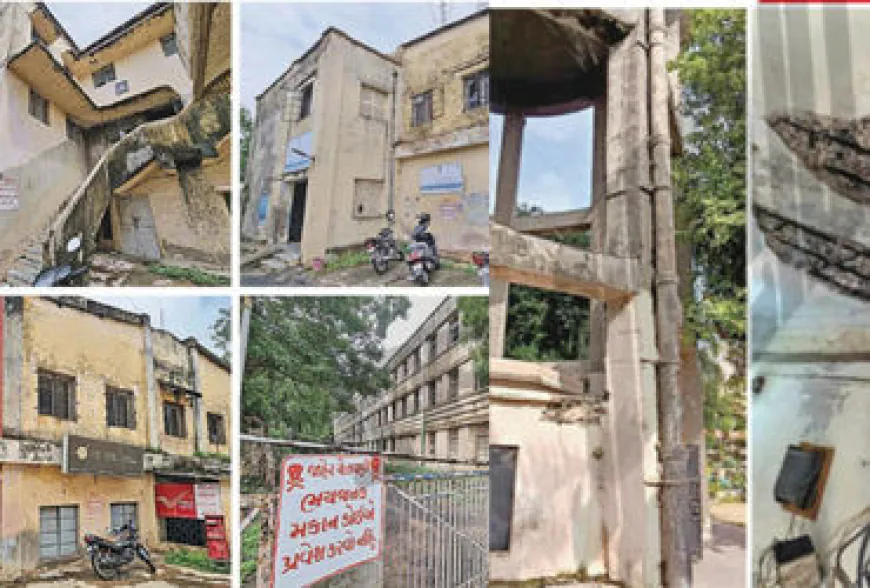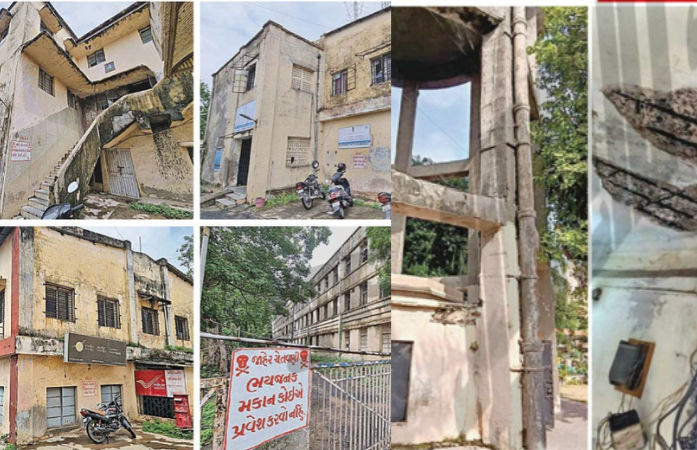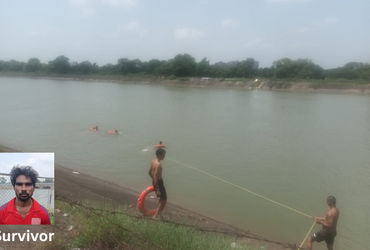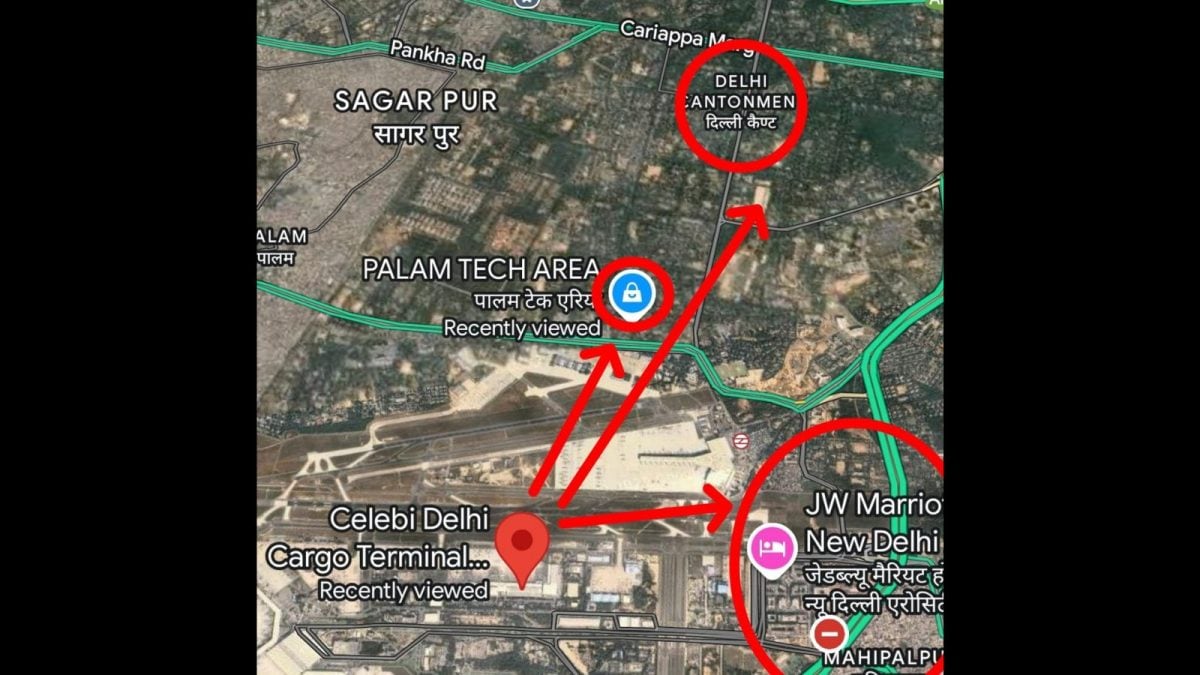Will the government wake up? Hazardous buildings across city posing threat to public
Buildings with “This building is dangerous” boards are common across Gujarat, including at the Women and Child Development Department office in the Polytechnic compound in Ahmedabad, where widows and children visit for government aid. While the public is forced to enter these hazardous offices, this reflects the negligence of the Gujarat government and responsible departments.After the Gambhira bridge accident, discussions have intensified about how many government offices across 30 departments in Gujarat operate from unsafe, dilapidated buildings, not just in the Polytechnic compound in Ahmedabad but across the state. Shockingly, even the Gandhinagar District Panchayat office, declared dangerous two years ago, continues to function in the same building.Unofficial figures indicate that in Ahmedabad, Vadodara, Surat, Rajkot, and Mehsana, there are 458 government-owned residential and non-residential buildings declared unsafe. Despite repeated inspections and requests for reconstruction, no action has been taken. Several offices across 30 government departments are functioning from these dilapidated structures, with reconstruction proposals pending in Gandhinagar. Dilapidated buildingsIn Ahmedabad, the Prohibition & Nashabandhi Office building near Ellisbridge has been in a dilapidated state for years. Despite generating revenue for the government, the building has not been repaired or reconstructed, forcing authorities to put up sheets during monsoon to prevent leaks. A similar condition prevails in Gandhinagar’s District Panchayat building, where employee associations have reported incidents of falling plaster injuring staff during monsoons, and walls have collapsed in the past.In the Polytechnic compound in Ahmedabad, several government offices, including the Women and Child Development Department and Bij Nigam, continue to operate despite the buildings being declared unsafe. While the district collector’s office previously operating here was shifted due to safety concerns, half a dozen other offices continue to function under threat, with ‘this building is dangerous’ boards displayed at entrances.After inspecting the Sarangpur tank on Saturday, the Municipal Commissioner directed officials to demolish the dilapidated tank and expedite the construction of the new one. According to Water Committee Chairman Dilip Bagaria, tenders for demolishing the old tank and constructing a new underground tank of 1.17 lakh liters and an overhead tank of 5 lakh liters were issued in January 2025. However, there is no clarity on when the work will start or be completed.Initially, the Archaeological Survey of India’s permission was cited as a hurdle, but after approval was granted, and with a budget of ₹24 crore, permission for construction was given. Yet, work has not commenced, forcing residents to continue struggling for water.Due to the negligence of Amdavad Municipal Corporation officials, around 60,000 residents of Khadia ward are forced to struggle for water during peak monsoon.On Saturday morning, the water supply from the Sarangpur water tank was stopped, forcing the corporation to supply water through 16 tankers across Balahanuman, Khadia Gate, Sarangpur, and surrounding areas.


Buildings with “This building is dangerous” boards are common across Gujarat, including at the Women and Child Development Department office in the Polytechnic compound in Ahmedabad, where widows and children visit for government aid. While the public is forced to enter these hazardous offices, this reflects the negligence of the Gujarat government and responsible departments.
After the Gambhira bridge accident, discussions have intensified about how many government offices across 30 departments in Gujarat operate from unsafe, dilapidated buildings, not just in the Polytechnic compound in Ahmedabad but across the state. Shockingly, even the Gandhinagar District Panchayat office, declared dangerous two years ago, continues to function in the same building.
Unofficial figures indicate that in Ahmedabad, Vadodara, Surat, Rajkot, and Mehsana, there are 458 government-owned residential and non-residential buildings declared unsafe.
Despite repeated inspections and requests for reconstruction, no action has been taken.
Several offices across 30 government departments are functioning from these dilapidated structures, with reconstruction proposals pending in Gandhinagar.
Dilapidated buildings
In Ahmedabad, the Prohibition & Nashabandhi Office building near Ellisbridge has been in a dilapidated state for years.
Despite generating revenue for the government, the building has not been repaired or reconstructed, forcing authorities to put up sheets during monsoon to prevent leaks.
A similar condition prevails in Gandhinagar’s District Panchayat building, where employee associations have reported incidents of falling plaster injuring staff during monsoons, and walls have collapsed in the past.
In the Polytechnic compound in Ahmedabad, several government offices, including the Women and Child Development Department and Bij Nigam, continue to operate despite the buildings being declared unsafe.
While the district collector’s office previously operating here was shifted due to safety concerns, half a dozen other offices continue to function under threat, with ‘this building is dangerous’ boards displayed at entrances.
After inspecting the Sarangpur tank on Saturday, the Municipal Commissioner directed officials to demolish the dilapidated tank and expedite the construction of the new one.
According to Water Committee Chairman Dilip Bagaria, tenders for demolishing the old tank and constructing a new underground tank of 1.17 lakh liters and an overhead tank of 5 lakh liters were issued in January 2025. However, there is no clarity on when the work will start or be completed.
Initially, the Archaeological Survey of India’s permission was cited as a hurdle, but after approval was granted, and with a budget of ₹24 crore, permission for construction was given. Yet, work has not commenced, forcing residents to continue struggling for water.
Due to the negligence of Amdavad Municipal Corporation officials, around 60,000 residents of Khadia ward are forced to struggle for water during peak monsoon.
On Saturday morning, the water supply from the Sarangpur water tank was stopped, forcing the corporation to supply water through 16 tankers across Balahanuman, Khadia Gate, Sarangpur, and surrounding areas.
What's Your Reaction?



















































































